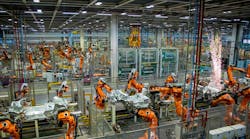Despite a prolonged period of slow productivity growth and low unemployment, some commentators continue to voice concern over the threat automation poses to jobs. This worry continues a long tradition of fear over the consequences of machines replacing workers. But the danger is that these views could result in policies that make us worse off, such as taxing or banning robots. If the history of automation teaches us anything, it is that while automation can temporarily displace some workers, it also raises living standards for society by reducing costs, improving quality and allowing people to concentrate on higher-value work.
A recent example of concern about automation appeared in a Fortune article by Geoff Colvin. Citing work by two economists, Daron Acemoglu and Pascual Restrepo, Colvin argues that automation has been a main cause of the decline in labor’s share of national income. Allegedly, this is because over the past decade most automation has taken over tasks that workers used to do, whereas relatively little automation has created new tasks that open up opportunities for humans to do new, more productive work.
There are two problems with this argument. First, a large body of economic evidence shows that capital investment, including automation, raises national income over the medium term. Although automation can displace workers, this effect has always resulted in higher incomes, lower prices and more choices for the majority of society. There is no reason to think this time will be different. In fact, if excessive automation were happening, we should expect to see larger productivity growth and higher unemployment.
Second, Colvin and many others simply assume that since the labor share of income has gone down, automation must be the culprit. But when we look at net income instead of gross, labor’s share has remained roughly constant at around 70 percent. Moreover, the relatively small recent decline is almost entirely explained by the rise in housing costs. From 2006 to 2017, labor’s share of income fell by 0.25 percentage points, while the share going to profits was unchanged. Rental income (which includes both actual rents and the imputed rents to homeowners), however, rose by 2.4 percentage points. The rise in rent income, in turn, is due mainly to local restrictions on building more units, not automation.
In summary, automation has always delivered vast benefits to society. Even in the midst of recessions, no one proposes doing away with existing automation in order to create jobs. Just as we would not ban backhoes and mandate that workers use only shovels, we should also embrace, not resist the continued march of other forms of automation. Given the recent trend of slow productivity growth, a skills gap, low unemployment and the swell of baby boom retirement, we should focus on enriching future workers by encouraging automation.
Joe Kennedy is a senior fellow at the Information Technology and Innovation Foundation, a nonprofit think tank whose mission is to formulate, evaluate, and promote policy solutions that accelerate innovation and boost productivity to spur growth, opportunity and progress. He focuses on economic policy.
This article was originally published on the ITIF blog. It is used with permission.




